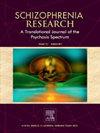精神分裂症谱系障碍的认知表现与纵向研究的数字表型相关
IF 3.5
2区 医学
Q1 PSYCHIATRY
引用次数: 0
摘要
社会和非社会领域的认知缺陷是精神分裂症功能障碍的核心。虽然这些缺陷传统上是通过神经心理学测试来评估的,但智能手机传感器驱动的数字表型的最新进展为持续实时监测日常行为提供了一种新的方法,可以反映潜在的认知功能。我们研究了50名参与者(25名诊断为精神分裂症谱系障碍的参与者和25名健康的对照组参与者)的数字表型指标(如在家时间、屏幕持续时间和熵)与社会和非社会认知功能之间的关系。使用MindLAMP应用程序在12个月内捕获被动数据。同时,在基线、6个月和12个月使用印度社会认知评定工具和精神分裂症认知简要评估进行认知评估。我们发现,在基线和六个月的时间点上,更长的在家时间与较差的社会认知(失态识别)有关。我们还观察到,第一个月或基线在家时间与随后6个月和12个月随访时的失礼识别有关。这些发现强调了数字表型标记(如家庭时间)作为精神分裂症社会认知缺陷的客观行为相关因素的潜力,为有针对性的干预措施提供了改善功能的机会。本文章由计算机程序翻译,如有差异,请以英文原文为准。
Digital phenotyping correlates of cognitive performance in schizophrenia spectrum disorders from a longitudinal study
Cognitive deficits across social and nonsocial domains are central to functional impairment in schizophrenia. While these deficits are traditionally assessed through neuropsychological testing, recent advancements in smartphone sensor-driven digital phenotyping offer a novel approach for continuous, real-time monitoring of daily behaviors that can be reflective of latent cognitive functioning. We examined the relationship between such digital phenotyping metrics like home-time, screen-duration, and entropy, and social and nonsocial cognitive functioning in 50 participants — 25 diagnosed with schizophrenia spectrum disorders and 25 healthy comparison participants. Passive data were captured using the MindLAMP app over 12 months. At the same time, cognitive assessments were conducted at baseline, 6, and 12 months using the Social Cognition Rating Tool in Indian Setting and Brief Assessment of Cognition in Schizophrenia. We found that greater home-time at baseline and six months was associated with poorer social cognition (faux-pas recognition) at those assessment time points. We also observed that first-month or baseline home-time was associated with subsequent faux-pas recognition at the 6 and 12-month follow-ups. These findings highlight the potential for digital phenotyping markers, such as home-time, to serve as objective behavioral correlates of social cognitive deficits in schizophrenia, offering opportunities for targeted interventions to improve functioning.
求助全文
通过发布文献求助,成功后即可免费获取论文全文。
去求助
来源期刊

Schizophrenia Research
医学-精神病学
CiteScore
7.50
自引率
8.90%
发文量
429
审稿时长
10.2 weeks
期刊介绍:
As official journal of the Schizophrenia International Research Society (SIRS) Schizophrenia Research is THE journal of choice for international researchers and clinicians to share their work with the global schizophrenia research community. More than 6000 institutes have online or print (or both) access to this journal - the largest specialist journal in the field, with the largest readership!
Schizophrenia Research''s time to first decision is as fast as 6 weeks and its publishing speed is as fast as 4 weeks until online publication (corrected proof/Article in Press) after acceptance and 14 weeks from acceptance until publication in a printed issue.
The journal publishes novel papers that really contribute to understanding the biology and treatment of schizophrenic disorders; Schizophrenia Research brings together biological, clinical and psychological research in order to stimulate the synthesis of findings from all disciplines involved in improving patient outcomes in schizophrenia.
 求助内容:
求助内容: 应助结果提醒方式:
应助结果提醒方式:


